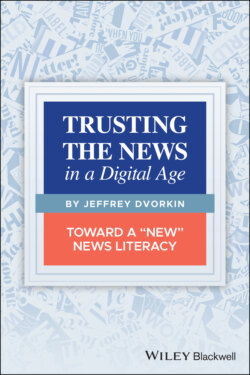Читать книгу Trusting the News in a Digital Age - Jeffrey Dvorkin - Страница 17
What's at Stake?
ОглавлениеWill we be able to connect with the original promise of the Internet – the promise that the news can make us more free, more democratic, more independent, and more connected? Or will we be moved into smaller and smaller units of self‐reliance, anti‐social behaviors, and disconnection? We will explore how the concept of news literacy can work to support our better social instincts. We will understand how the news works both for us and against us. And we will have the tools to do it properly.
As news organizations on every platform feel the pressure of public scrutiny, all media are attempting to find ways to restore and enhance their reputations with the public. This is not just a matter of holding up the news standards, there is also a financial consequence: it’s called journalistic credibility.
Finding ways to manage the ethical issues around credibility has become a matter of some urgency for many news organizations. As the accusations of bias proliferate from partisan corners of the Internet, journalism has been put on the defensive.
While some news organizations have gone public by placing their ethical guidelines and practices on their websites for all to see, we have also seen a renewed effort by academics to help the public and media organizations find more useful ways of informing the public about best practices when it comes to journalistic and media ethics.
The Scripps Howard School of Journalism at the University of Ohio has been at the forefront of discussions about choosing the best option when confronted with an ethical dilemma. Or in some cases, choosing the least‐worst option.
Another resource is the Potter Box, a model devised by Ralph Potter, Jr., a professor of social ethics at Harvard Divinity School, to sort out the steps one needs to take to come to a proper decision on a complicated ethical matter when the solution is neither easy nor evident.
Potter thought it would be a good way for his students studying moral ethics to come to the right decisions about complicated dilemmas. But it also can work for journalism and the news too.
This is what it looks like:
